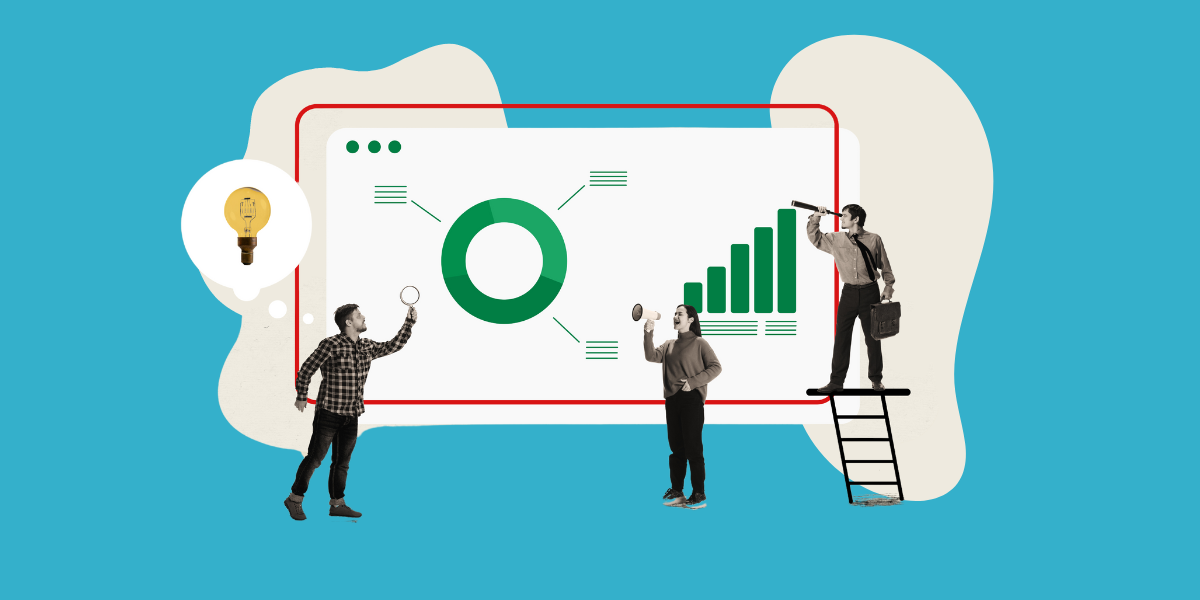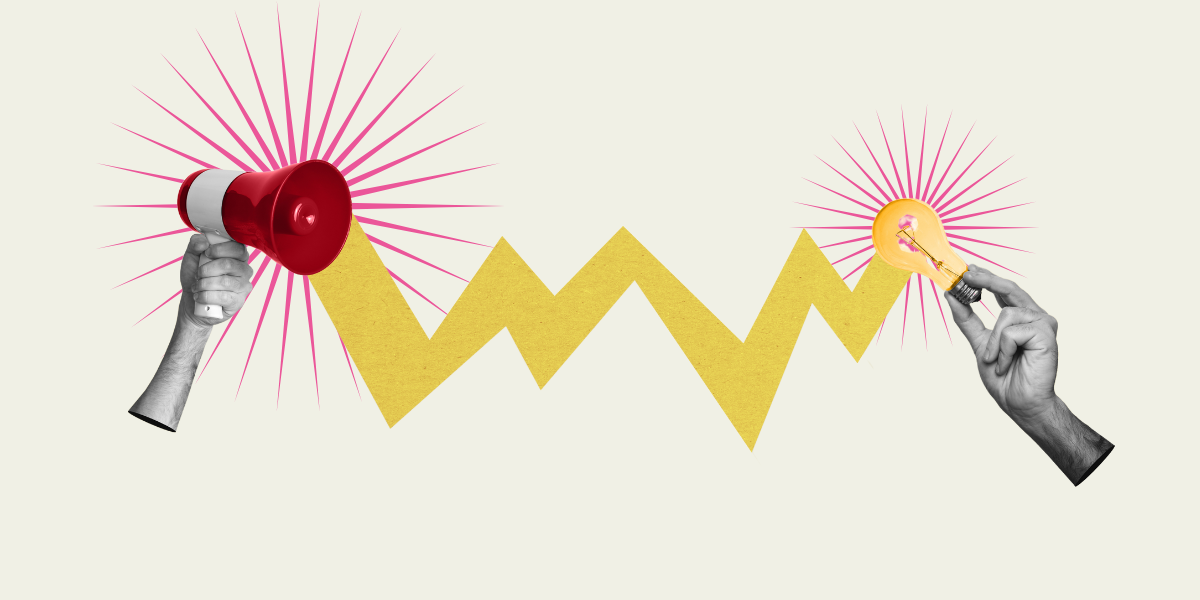Sales funnel vs sales pipeline: the complete guide
Table of content
- Sales pipeline vs Sales funnel: what’s the difference?
- What is a sales pipeline?
- Metrics to track in your sales pipeline
- The benefits of a sales pipeline
- Make sure to incorporate a pipeline review
- What is a sales funnel?
- How to develop your sales funnel
- The benefits of a sales funnel
- Be wary of sales funnel leakage
- Why optimise your sales pipeline?
- Why analyse your sales funnel?
Sales funnel vs sales pipeline: The complete guide
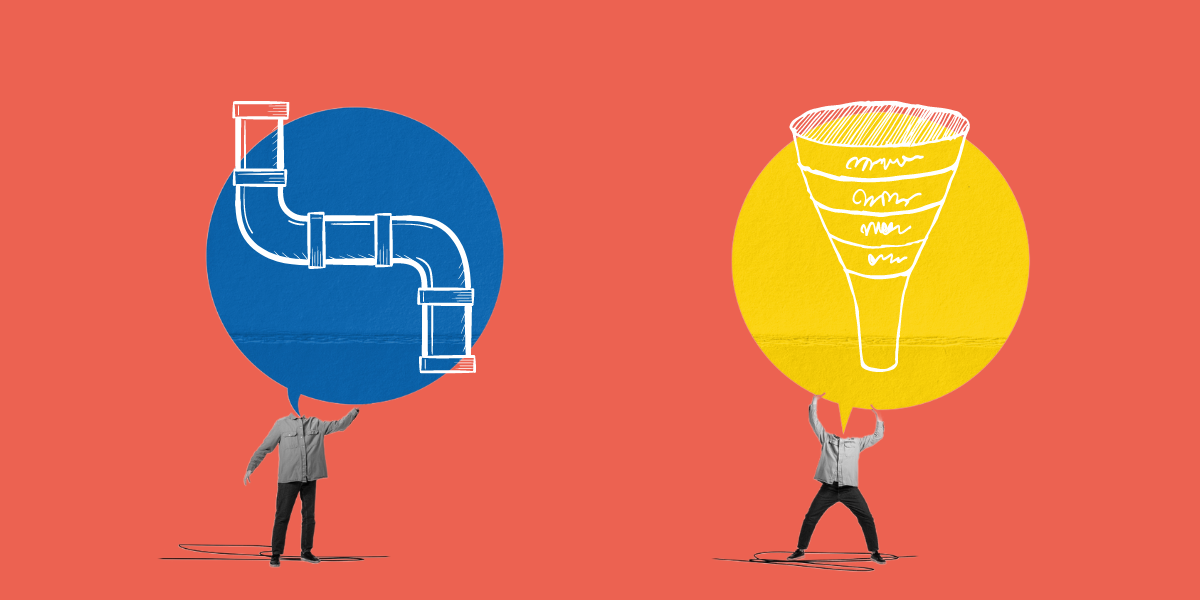
Get the full picture and understand the difference between a sales funnel and a sales pipeline and how they can benefit your business.
Sales funnel vs sales pipeline. It might not make it onto Sky Box Office any time soon, but it’s an often confusing battle in the sales and marketing world.
Many people think of them as the same thing, but they are distinct concepts. From the seller’s point of view, the sales funnel is the story of leads, whereas the sales pipeline is the story of deals.
It might seem like a needless marketing theory definition, one learnt in lecture halls and books rather than down in the sales trenches of the real world, but knowing the difference can be crucial to understanding and optimising.
I have no idea why these important processes are named after plumbing items, but there we go. I’d have jazzed them up a bit to add a touch of excitement: the sales pipeline could have been the sales flume, and the sales funnel could be, I don’t know, the sales zip wire? As it is, we’re stuck with the names. But don’t let that stop you from reading on.
Sales pipeline vs Sales funnel: what’s the difference?
A sales pipeline represents the process a consumer goes through to become a customer, from the point they express interest to the point they sign a deal. The sales funnel represents the number of prospects who make it through the different stages from being aware of your brand to purchasing from you.
A sales pipeline looks at the different steps in the sales process, from gaining the lead to closing the sale. It is brand-focused, looking internally at the stages your sales and marketing teams need to move a prospect through to make them a customer and retain them.
A sales funnel looks at the whole customer journey, from first becoming aware of a brand to making a purchase. It is customer-focused in that it looks at the various stages a consumer will go through in their journey towards purchase.
What is a sales pipeline?
We’ve established that a sales pipeline is a set of stages a prospect journeys through as they progress from a lead to a customer. What does this mean in practice?
If we break down each pipeline stage, we can see why some might confuse it for the sales funnel. As each stage passes, fewer prospects progress to the next stage.
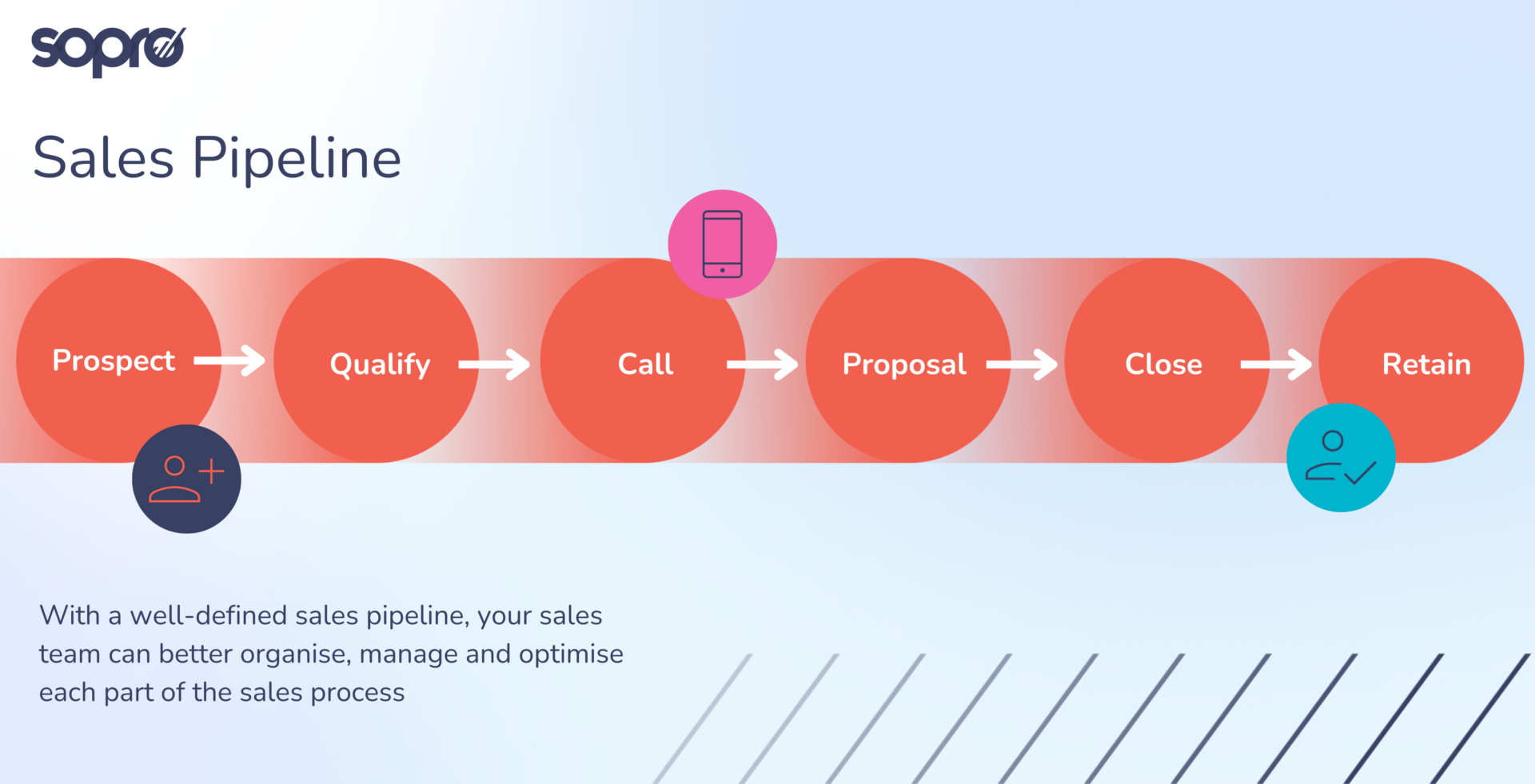
Lead generation
The first step is generating new leads. For us, that’s prospecting, but any type of lead generation will be assigned to this first stage of the pipeline. A big chunk of the sales funnel is concerned with this first stage.
Qualify leads
Next up, your sales team should qualify those leads in some way. Lead scoring is a common way to do this. Qualifying leads makes sales teams more efficient as they focus on quality rather than volume.
Call or meeting
The reason salespeople get out of bed in the morning. The sales call or meeting comes next. In reality, this stage might consist of multiple contacts. Clearly, a key stage, the amount and quality of leads that have come through the previous stages of the pipeline, will directly affect the success of the sales meetings.
Proposal
After the sales call, the salesperson sends the prospect a detailed quote outlining the cost and the terms, including the length of the contract and what is included.
Close
Coming into the home straight, sales conduct any final negotiations, sign the contracts, and close the deal. At this stage, the prospect has journeyed through the pipeline to become a customer. Yey.
Retain
What’s this? Another step after closing? Although often left off sales pipelines, customer retention and loyalty should be considered part of the process. While the responsibility will shift away from the sales team and towards client services and marketing, reducing churn rate and increasing customer lifetime value is an integral part of the journey and vital for business success.
Metrics to track in your sales pipeline
Your sales pipeline’s quality can be measured. Tracking key metrics allows you to optimise your sales process.
To continually optimise and focus your efforts, it is vital to keep an eye on:
- Number of deals in the pipeline: this will help you predict your output and give an accurate idea of whether or not your sales team are on track
- Average deal size: this will help calculate how big the deals are in a given period and will highlight which products or features are your most popular
- Average win rate: how many leads are converted into customers – assesses the quality of your pipeline and the performance of your team
- Sales cycle length: this calculates how long someone sits in your pipeline from lead to customer (also known as sales velocity). It can identify points in your pipeline that might slow or hinder the sales journey
The benefits of a sales pipeline
The key benefits of tracking a prospect’s journey include gaining insight into deals, measuring performance, and predicting revenue.
A well-constructed sales pipeline provides sales reps with actionable insights into potential deals, allowing them to focus on high-value opportunities and giving them a target to strive for. This visibility also helps you to identify your team efforts and where to allocate output to optimise productivity.
A sales pipeline is a powerful forecasting tool, helping businesses accurately predict revenue by analysing deal progress and potential values.
This will streamline your sales process, enhance decision-making, and boost company revenue generation.
Make sure to incorporate a pipeline review
Check in with your teams! A sales pipeline review is an opportunity to sit down with your sales reps to assess what the pipeline is currently looking like, how the sales process is functioning, and if there are any obstacles.
You should review your pipeline periodically – here’s what’s valuable to focus on:
- Sales team wins. It’s a great way to start your team reviews – keeping your team motivated is important!
- Pipeline updates, including time in the pipeline, deals expected to close soon and deals that haven’t moved along and identifying why
- Roadblocks including low-quality leads, sales objections that are continually cropping up and any internal issues that are hindering pipeline movement.
- Be sure to monitor your competitors and how that might affect your sales pipeline.
What is a sales funnel?
The sales funnel looks at the whole customer journey from the point of view of a lead. The funnel is often illustrated differently, so it may not always feature the six stages outlined here. A common, simpler version shows AIDA – Awareness, Interest, Desire, and Action.
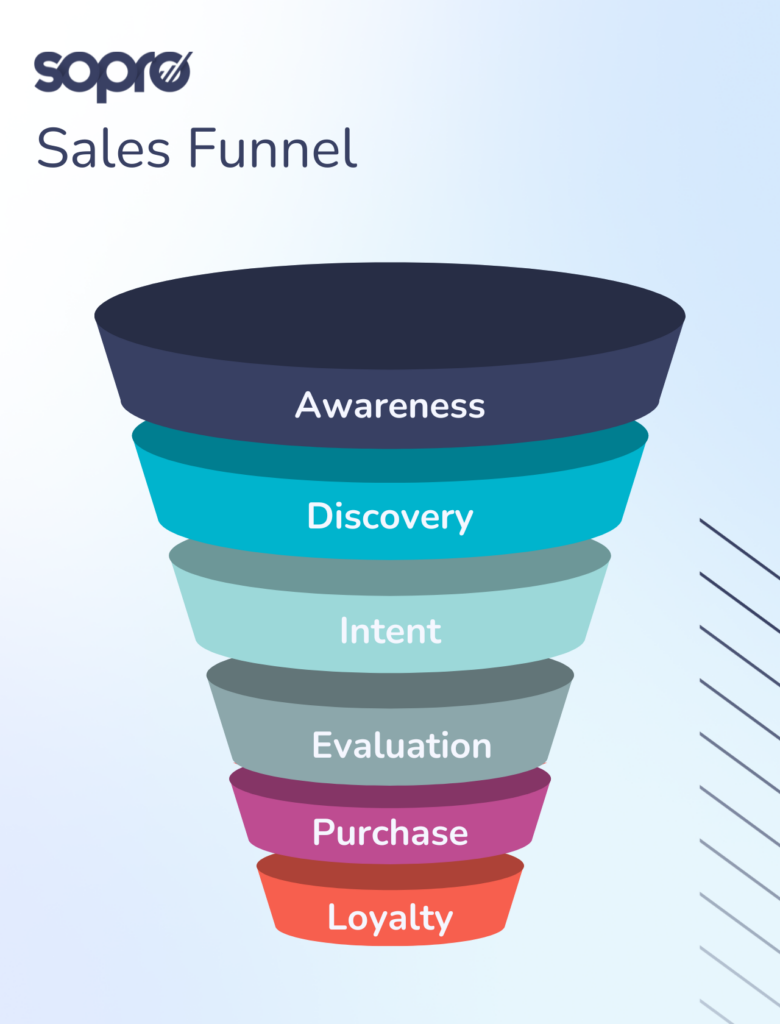
Broadly speaking, everyone agrees that there are three overarching stages. First is top of the funnel (TOFU), which describes the awareness and discovery phases. Here, the lead is first brought into your orbit through marketing.
Next is the middle of the funnel (MOFU), which covers evaluation and intent. The lead begins to consider making a purchase with you.
Finally (and I think you’re probably ahead of me on this one) is the bottom of the funnel (BOFU), where purchase and loyalty happen.
Awareness
The prospect first hears about your service or product in the awareness stage. That could be via a Google search, a social post, a radio ad, or a prospecting campaign.
The prospect may be looking for a solution to their problem or become aware at a stage where they have no immediate need.
Discovery
During the discovery phase, a prospect has become interested enough to learn more about you. They begin to undertake further research. This is an opportunity to create educational content that sits beyond the brand awareness phase and begins to dive into further detail about ways you can help.
Create the right content, and the prospect may read more of your content, check your social media feeds, and browse your website. The prospect will most likely be undertaking the same research with other possible solutions.
Evaluation
Research steps up in earnest; the prospect will dive into your offering. Comparisons between competitors also come to the forefront of the consideration. Review sites and word-of-mouth become more critical, but well-crafted content will still play an important part.
Intent
When they enter the intent phase, the prospect intends to buy from you. Job done, right? Not so fast.
The prospect wants (and in the B2B world, must) make sure your proposal encompasses everything they need, and that it is within budget. Proposals are finalised, terms are negotiated, and objections are handled.
Purchase
The ink dries as the deal is done, and your sales team can bang a gong and light a victory cigar.
Although this is often called the honeymoon phase, it’s not a time to sit back. Depending on what your business sells, a well-designed onboarding process can be a vital follow-up to the purchase and can significantly reduce customer churn.
Loyalty
Beyond closing, opportunities exist to provide further value, foster loyalty, upsell, and gain referrals. Continuing to market to your customers increases the likelihood of another sale or contract renewal.
How to develop your sales funnel
In five quick and easy steps, you can build a sales funnel that identifies and makes the most of those quality leads! The trick? Understanding a buyer at every stage of the process, reaching out to them where they are and most importantly, following up.
Developing a sales funnel: a snapshot
- Get a handle on your existing customers
A proactive sales funnel that will benefit your business needs is one that has extensive customer data. Be sure to communicate with those already sitting within your CRM. Are their details up to date? Have you been tracking outgoing interactions and inbound intent? This will give you a broad view of who sits where in the funnel and how to optimise outreach going ahead. - Engage and nurture your target audience
To capture the attention of prospects and get them working through the funnel, you need to make the most of inbound and outbound channels.
Second, your content needs to be educational and informational – demonstrate how your product or service will serve as a solution.
Ensure you know your buyer personas and ideal customer profile well. You’ll achieve more targeted and personalised messaging by understanding where and how they consume information and what content appeals. - Develop a stand-out landing page
Don’t create aimless content – you need to be navigating prospects to a landing page. Here, you can swap details for a free trial, show off your prowess with some social proof, or provide details and benefits of your offering.
This is where you need to have a prominent call to action. What is the next step for your prospect? Entice them into your sales funnel.

Create a landing page that…lands
We reveal four simple ways to turn your landing page into lead laboratories.
Find out more- Keep your leads toasty
At this stage, you should have a set of contact details. This is where your outreach campaign begins, usually with email. After all, we know that 67% of buyers want to be contacted by email.
Your campaign messaging should continue to inform and educate and should start to build rapport. Throw out the cold sales pitch and encourage leads to become paying customers through personalised and valuable content. - The art of the follow-up
Whether your leads have converted or are still in their funnel, it’s essential to continue your outreach – but be careful not to bombard them.
You could lose up to 76% of leads by not following up, so continue delivering personalised, valuable content until conversion, or they signify no interest.
This goes for converted customers, too! Don’t leave them hanging just because they’ve made a purchase. Build on customer satisfaction with news on product updates or just check how your product or service is working for them. This will also go a long way in developing social proof.
The benefits of a sales funnel
Ultimately, the sales funnel makes the buying process seamless and pain-free for your prospects. This is excellent news. The easier you move buyers through the funnel, the more likely they are to convert.
And it shows. Suppliers who create an effortless buying journey are 62% more likely to see high-quality sales.
Second, your funnel will help with your bottom-of-the-funnel strategies, allowing your teams to focus on keeping current customers engaged in your offering and aiding overall retention.
You’ve also got the benefit of leveraging targeted and personalised messaging. By understanding where buyers are sitting in the funnel, your teams can provide content that is more suited to their needs and the information they are looking for. With 71% of buyers now expecting personalised outreach, having a handle on your funnel is a no-brainer.
Be wary of sales funnel leakage
It sounds funky, but sales leakage is just a term used to represent lost leads, dwindling traffic or a downturn in sales and what that looks like in your funnel.
There can be many reasons for leakage. Some of those include leads being assigned to sales reps on holiday, an over-stretched team, confusing messaging, a landing page that doesn’t quite hit, an offer that doesn’t resonate with your target market, and so much more.
But it’s not all doom and gloom.
By having a sales funnel in the first place, you can quickly identify where those typical drop-off points are, which will help you optimise them.
To fix your leak, it’s essential to look at all areas. Some of the aspects that you can assess include:
- Data: are there holes in your CRM? Do you have the most up-to-date contact details?
- Value proposition: it might be aligned with your business goals, but does it resonate with those customer needs?
- Lead nurturing: are you making the most of testimonials? Have you got the right calls to action? Is there room for improvement in your outreach strategy?
- Onboarding: is this onboarding process easy for the customer?
Get stuck in with your sales and marketing teams – they’re the experts in looking at that data and seeing where those sticking points might be. Always be open to adaptation!
Why optimise your sales pipeline?
OK, so it’s pretty clear that any business should optimise its sales funnel. But in keeping with highlighting the difference between a sales pipeline and a sales funnel, we’re going to outline how the two differ.
Analysing your pipeline can help you gain a clearer picture of timescales. How long do leads take to convert? We recently analysed our conversion timescales and made some surprising discoveries. You may find that one part of your process is taking too long, so you can focus on optimising that stage.
One great way of doing this is calculating your sales velocity, which can reveal the speed at which deals move through your pipeline and highlight any issues.
Digging into your sales pipeline reports allows you to understand pipeline weaknesses. There may be ineffective or unnecessary processes which can be removed to improve the flow of leads towards the sale.
Optimising your pipeline can be highly efficient; if the change is quick to implement, it will have an immediate effect. You can analyse on a team or individual level, understanding if blockages are down to a team process or an individual weakness.
Why analyse your sales funnel?
Understanding the ROI of marketing is vital to driving new business, and that’s a benefit of analysing sales funnels.
A proper sales funnel analysis allows you to understand how many leads you need to generate a sale. From this, you set departmental targets and plan organisational growth.
This data crunching will also reveal the varying quality of leads from different channels. If the conversion rate from a particular source is significantly lower than others, you may want to examine if that channel works, as well as the initial numbers suggest.
Finally, and significantly, you can speed up your sales process. If qualified leads from a reliable channel are not converting between the call and the close, it may be that leads are taking too long to get through the funnel.
Looking for more leads for your sales pipeline and sales funnel? Sopro is an award-winning multi-channel prospecting service like no other.


